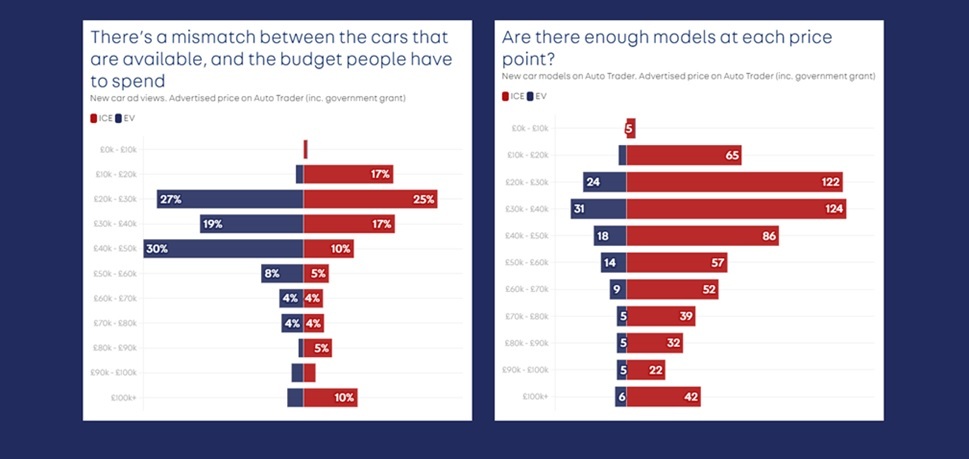
The recent rapid increase in sales of electric vehicles (EVs) masks a huge divide between wealthy motorists and the mass market, according to Auto Trader.
Speaking at a panel event on EV policy in Glasgow Ian Plummer, Commercial Director of Auto Trader, has called for targeted incentives to drive mass adoption of EVs.
Setting out a three point EV manifesto, Plummer warned that the UK is in danger of being left behind as manufacturers may choose to focus on markets such as France and Germany where the incentives on offer to consumers and the automotive industry are more attractive.
Auto Trader’s Manifesto for the Mass Adoption of EVs has three principal clarion calls:
Give people the means to be greens
The UK government’s £620m investment in grants for electric vehicles and street charging points, announced last month and referenced again in the Budget, is welcome, but Ministers should consider how that investment is targeted. Even if all those funds were used to boost sales it would likely only subsidise about 120,000 vehicles, and even then it will not bring EVs within the price range of those in middle and lower incomes given the current price disparities.
The average EV is currently 38% more expensive to buy than its nearest petrol or diesel equivalent while a nearly new volume brand EV hatchback is on average £10,000 more expensive than the equivalent ICE vehicle. At present, used EVs only start to make financial sense when they are four years old.

Auto Trader data shows that interest in electric vehicles is coming almost exclusively from wealthier postcodes. Six of the Top 10 EV hotspots are to be found in affluent areas of London, including Putney and Kensington. Across the UK the pattern is the same, with higher interest in towns and cities such as Harrogate, Bath and the wealthy areas south of Manchester.
In fact, compared with the car buying average, those with the highest interest in making the switch are twice as likely to have a household income of £75k or more. (See Table 1 for comparison of social grades for those searching for an EV versus the Auto Trader population).
Sell the EV experience not just the green credentials
Manufacturers and retailers should shift the emphasis in EV marketing from sustainability to more personally relevant benefits such as superior performance, enjoyment and total cost of ownership.
Research conducted by Auto Trader last year suggests that motorists do not think the performance of EVs is as good as ICE vehicles. For years, advertising has tried to give people an emotional reason to buy cars, but that hasn’t been the case with EVs.
Ramp up the volume
One of the big impediments to EV adoption has been the relative lack of choice. While the choice of electric cars is now starting to accelerate with a threefold rise since the start of last year, there’s clearly a long way to go. In fact, buyers considering ICE cars still have six times the choice compared with EVs.
More and more electric cars are being introduced, but most are in the more expensive segments – anyone looking for a supermini or city car has very limited options.
For manufacturers, the economics of EVs stack up less well in the more affordable and high volume segments, but this is precisely the part of the car market that EVs need to crack if we are to drive mass adoption. The government has a role to play in ensuring that the UK is an attractive place for manufacturers to introduce new EV options into high volume segments of the car market.
There are just four electric models priced below £20,000, but this is where we see 20 per cent of views of new cars. Buyers looking for an affordable electric car still don’t have enough options.
Conclusion:
Greater incentives to make EVs more accessible to all income level households are needed, both on new and used cars. It’s important that further incentives benefit mass market buyers. This could mean creating a means tested grant to ensure EVs don’t remain the preserve of the rich.
Other incentives for EV owners, similar to those already offered in other countries like Norway and France, such as reduced road tax, free parking or reduced toll charges will also greatly benefit adoption levels. Ultimately car buyers need to be incentivised to make the switch.
More investment is needed to overcome consumer anxieties surrounding the charging of EVs. The current charging infrastructure needs widespread investment so it can offer drivers flexible solutions to their charging needs. As geographies and lifestyles differ across the UK, so too must charging solutions.
More information is needed to make buying and owning an EV accessible and relevant to all. Consumers need to understand the financial benefits of owning an EV, especially the government grants that are available and the total cost of ownership (TCO) savings that EVs present.
The quarterly Road to 2030 Report is available to view at www.autotraderroadto2030.co.uk
